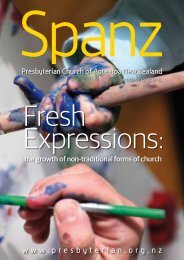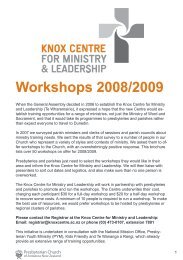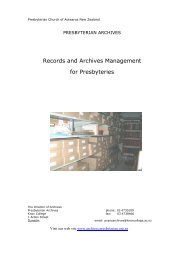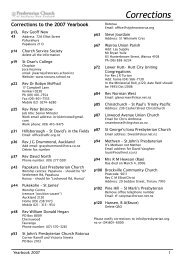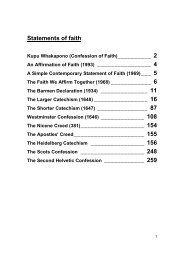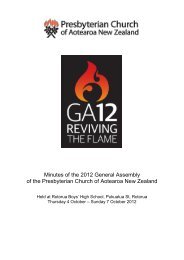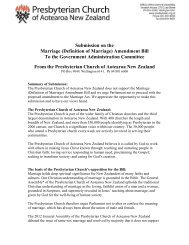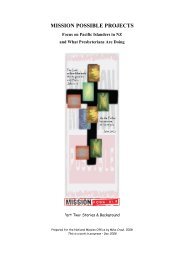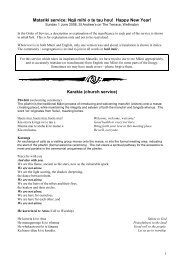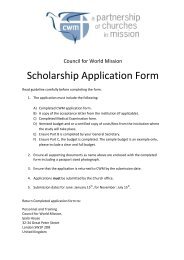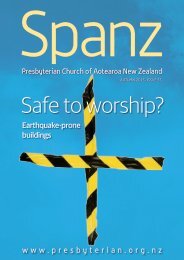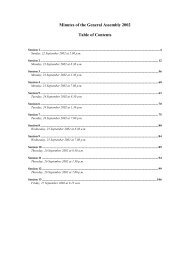Cultural diversity and unity in Christ: the Presbyterian Church of ...
Cultural diversity and unity in Christ: the Presbyterian Church of ...
Cultural diversity and unity in Christ: the Presbyterian Church of ...
Create successful ePaper yourself
Turn your PDF publications into a flip-book with our unique Google optimized e-Paper software.
nature”. 9 Most see <strong>the</strong> whole concept <strong>of</strong> race as a recent modern assumption, based on a debatable<br />
concept <strong>of</strong> ‘biological essentialism’, <strong>of</strong>ten developed <strong>in</strong> order to exert social controls over certa<strong>in</strong><br />
groups, <strong>and</strong> <strong>the</strong>refore better to be discarded. However most feel it is better to cont<strong>in</strong>ue to use <strong>the</strong><br />
language while recognis<strong>in</strong>g that it refers to one facet <strong>of</strong> identity that is constructed ra<strong>the</strong>r than given.<br />
It is certa<strong>in</strong>ly not a static category which predeterm<strong>in</strong>es how people assigned or tak<strong>in</strong>g that identity<br />
will th<strong>in</strong>k <strong>and</strong> act. Ra<strong>the</strong>r it is a fluid <strong>and</strong> dynamic concept <strong>and</strong> <strong>in</strong>dividuals negotiate racial <strong>and</strong> ethnic<br />
attributions amidst a variety <strong>of</strong> social constra<strong>in</strong>ts. As people <strong>of</strong> a particular ethnic group move from<br />
one place to ano<strong>the</strong>r, obviously <strong>the</strong>y face a new set <strong>of</strong> social constra<strong>in</strong>ts, <strong>and</strong> negotiate over time how<br />
that identity is lived out for <strong>the</strong>m <strong>in</strong> <strong>the</strong>ir new context. It is “self perceived <strong>and</strong> people can belong to<br />
more than one ethnic group” 10 , as <strong>the</strong> NZ Census now allows.<br />
Modern def<strong>in</strong>itions <strong>of</strong> an ethnic group <strong>in</strong>clude <strong>the</strong> follow<strong>in</strong>g elements: 11<br />
1. A common proper name, to identify <strong>and</strong> express <strong>the</strong> ‘essence’ <strong>of</strong> <strong>the</strong> comm<strong>unity</strong>.<br />
2. A myth <strong>of</strong> common ancestry, which <strong>in</strong>cludes <strong>the</strong> idea <strong>of</strong> a common orig<strong>in</strong> <strong>in</strong> time <strong>and</strong> place.<br />
3. Shared historical memories, <strong>in</strong>clud<strong>in</strong>g heroes <strong>and</strong> events.<br />
4. One <strong>of</strong> more elements <strong>of</strong> a common culture, which normally <strong>in</strong>clude language, religion <strong>and</strong><br />
customs.<br />
5. A l<strong>in</strong>k with a homel<strong>and</strong> to which <strong>the</strong>re is a symbolic attachment.<br />
6. A sense <strong>of</strong> solidarity on <strong>the</strong> part <strong>of</strong> <strong>the</strong> population.<br />
For reflection/discussion<br />
How do you respond to <strong>the</strong> def<strong>in</strong>itions put forward here? To what extent do you th<strong>in</strong>k ethnicity is a<br />
given <strong>and</strong> to what extent socially developed?<br />
This def<strong>in</strong>ition raises <strong>the</strong> question <strong>of</strong> <strong>the</strong> relationship between ethnicity <strong>and</strong> culture. Hav<strong>in</strong>g a common<br />
culture is part <strong>of</strong> what forms an ethnic group, <strong>and</strong> so with<strong>in</strong> a s<strong>in</strong>gle race <strong>of</strong> people <strong>the</strong>re may be<br />
several ethnic groups. This can be seen today <strong>in</strong> many <strong>of</strong> <strong>the</strong> major racial groups, Asian, African <strong>and</strong><br />
European be<strong>in</strong>gs examples. For much <strong>of</strong> recent history most countries have been populated<br />
predom<strong>in</strong>antly by people <strong>of</strong> <strong>the</strong> same ethnicity. However <strong>the</strong> recent global migration has meant that<br />
for many countries, as we have seen with <strong>the</strong> NZ figures, <strong>the</strong> population has become <strong>in</strong>creas<strong>in</strong>gly<br />
made up <strong>of</strong> several different ethnicities. Because <strong>of</strong> <strong>the</strong> strong relationship between ethnicity <strong>and</strong><br />
culture <strong>the</strong>se societies have come to be termed multicultural (ra<strong>the</strong>r than multiethnic) <strong>and</strong> <strong>in</strong> countries<br />
such as Australia <strong>and</strong> Canada this is an <strong>of</strong>ficial policy. In NZ <strong>the</strong> situation is a bit more complex<br />
because we are <strong>of</strong>ficially a bicultural country, with Maori as <strong>the</strong> Tangata Whenua, but are hav<strong>in</strong>g to<br />
come to terms with <strong>the</strong> fact that we are also multicultural, <strong>and</strong> <strong>in</strong> particular Asian-Pacific. Just how<br />
those two concepts sit toge<strong>the</strong>r is <strong>in</strong> a situation <strong>of</strong> at times uneasy flux.<br />
For reflection/discussion<br />
Is <strong>the</strong>re a conflict between biculturalism <strong>and</strong> multiculturalism? How do you imag<strong>in</strong>e <strong>the</strong>m fitt<strong>in</strong>g<br />
toge<strong>the</strong>r <strong>in</strong> NZ?<br />
For most <strong>of</strong> NZs post-European history <strong>the</strong> pattern <strong>of</strong> relationship between different ethnic groups, as<br />
<strong>in</strong> all countries where European settlers become <strong>the</strong> dom<strong>in</strong>ant population, assumed assimilation <strong>of</strong><br />
o<strong>the</strong>r groups to European culture, <strong>in</strong>clud<strong>in</strong>g Maori. At times punitive measures were enacted to br<strong>in</strong>g<br />
this about, such as prohibit<strong>in</strong>g <strong>the</strong> speak<strong>in</strong>g <strong>of</strong> Maori language <strong>in</strong> schools. In <strong>the</strong> 1960s <strong>and</strong>,<br />
particularly, <strong>the</strong> 1970s that pattern began to be challenged <strong>and</strong> most countries embraced some k<strong>in</strong>d <strong>of</strong><br />
model <strong>of</strong> cultural pluralism, or multiculturalism as it came to be called. This assumed that each group<br />
ma<strong>in</strong>ta<strong>in</strong>s many <strong>of</strong> its dist<strong>in</strong>ctives while still identify<strong>in</strong>g with a common society <strong>and</strong> accept<strong>in</strong>g some<br />
common norms. It is important to dist<strong>in</strong>guish between <strong>the</strong> term multicultural <strong>and</strong> multiculturalism. To<br />
9 John Stone, Race <strong>and</strong> Ethnicity: Comparative <strong>and</strong> Theoretical Approaches (Oxford: Blackwell, 2003) 33.<br />
10 Edw<strong>in</strong> Pio, Long<strong>in</strong>g & Belong<strong>in</strong>g: Asians, Middle Eastern, Lat<strong>in</strong> American <strong>and</strong> African Peoples <strong>in</strong> New<br />
Zeal<strong>and</strong> (Well<strong>in</strong>gton: Dunmore, 2010) 49.<br />
11 David G. Horrell, “Race, Nation, People: Ethnic Identity-Construction <strong>in</strong> 1 Peter 2.9”, New Test. Stud. 58,<br />
2011, 123-143.<br />
5



